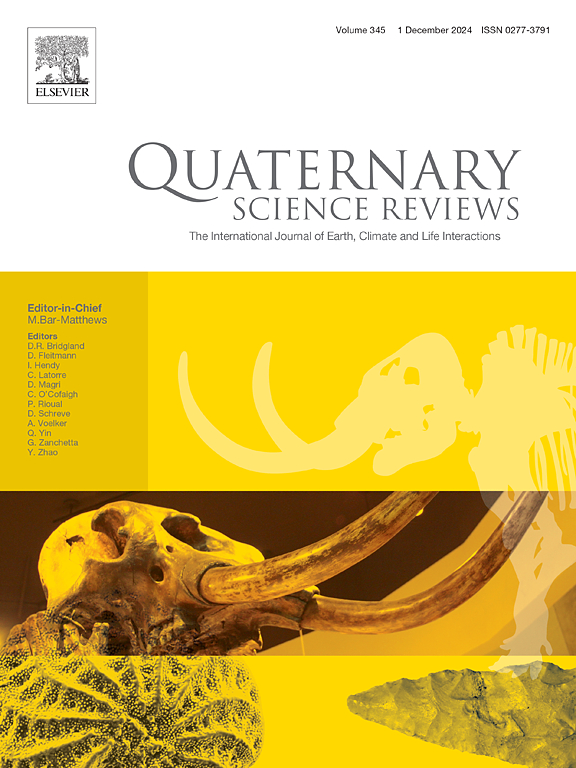sedaDNA and pollen disclose treeline advancing and plant diversity trajectory under recent climate warming in southwestern Hengduan Mountains, China
IF 3.2
1区 地球科学
Q1 GEOGRAPHY, PHYSICAL
引用次数: 0
Abstract
The ongoing climate warming has been casting unprecedented impacts on alpine ecosystems within the Hengduan Mountain (HDM), a globally renowned biodiversity hotspot. However, current knowledge of how alpine vegetation and plant diversity are responding to recent climate warming remains inadequate. Here, we conducted pollen and sedimentary ancient DNA (sedaDNA) analyses on a short sediment core from Tiancai Lake, located in the southwestern HDM, to explore the vegetation and plant diversity changes over the past four centuries. The results manifested that the regional vegetation composition has undergone obvious changes during this period. Specifically, the ratio of broad-leaved to coniferous taxa (B/C), as well as palynological richness and diversity, exhibited significant correlations with the increasing mean annual temperature, implying that alpine species in the southwestern HDM have been subjecting to recent climate warming trends. The sedaDNA results further illustrated watershed-scale vegetation turnover, characterized mainly by the replacement of Rhododendron scrub by Abies forest and the upward migration of the alpine ecotone. The establishment of alpine coniferous forest around Tiancai Lake occurred about 1880 C.E. Additionally, the trajectories of plant diversity on watershed scale were highly resembled the mean annual temperature variations during post-industrial warming, indicating that the plant diversity around Tiancai Lake should be highly sensitive to and controlled by climate changes. Concurrently, warming-induced alpine habitat degradation may be imperiling plant diversity in the Tiancai Lake region, despite the upward trend in palynological diversity observed in the southwestern HDM.

气候变暖背景下横断山西南地区林木线推进和植物多样性变化趋势
持续的气候变暖对全球著名的生物多样性热点——横断山的高山生态系统造成了前所未有的影响。然而,目前关于高山植被和植物多样性如何响应近期气候变暖的知识仍然不足。在此,我们对位于HDM西南部的天彩湖的短沉积物岩心进行了花粉和沉积古DNA (sedaDNA)分析,以探索过去四个世纪的植被和植物多样性变化。结果表明,这一时期区域植被组成发生了明显变化。其中,阔叶与针叶分类群的比值(B/C)以及孢粉丰富度和多样性与年平均气温的升高呈显著相关,表明西南高寒地区的高寒物种受到近年来气候变暖趋势的影响。sedaDNA结果进一步说明了流域尺度的植被更替,主要表现为冷杉林取代杜鹃灌丛和高寒交错带的向上迁移。天彩湖周边高山针叶林的形成始于公元1880年左右,流域尺度上植物多样性的变化轨迹与后工业增温时期的年平均气温变化轨迹高度相似,表明天彩湖周边植物多样性对气候变化高度敏感并受其控制。与此同时,气候变暖导致的高寒生境退化可能危及天彩湖地区的植物多样性,尽管在HDM西南部观测到孢粉多样性呈上升趋势。
本文章由计算机程序翻译,如有差异,请以英文原文为准。
求助全文
约1分钟内获得全文
求助全文
来源期刊

Quaternary Science Reviews
地学-地球科学综合
CiteScore
7.50
自引率
15.00%
发文量
388
审稿时长
3 months
期刊介绍:
Quaternary Science Reviews caters for all aspects of Quaternary science, and includes, for example, geology, geomorphology, geography, archaeology, soil science, palaeobotany, palaeontology, palaeoclimatology and the full range of applicable dating methods. The dividing line between what constitutes the review paper and one which contains new original data is not easy to establish, so QSR also publishes papers with new data especially if these perform a review function. All the Quaternary sciences are changing rapidly and subject to re-evaluation as the pace of discovery quickens; thus the diverse but comprehensive role of Quaternary Science Reviews keeps readers abreast of the wider issues relating to new developments in the field.
 求助内容:
求助内容: 应助结果提醒方式:
应助结果提醒方式:


